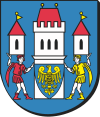 Alternate names: Skoczów [Pol], Skotschau [Ger], Skočov [Cz]. 49°48' N, 18°48' E, 53 miles WSW of Kraków, in former Silesia. 1900 Jewish population: about 300. Yizkor: W cieniu skoczowskiej synagogi : praca zbiorowa, wydana z okazji 100 rocznicy powstania zydowskiej gminy wyznaniowej w Skoczowie (Skoczow, 1994). This town and seat of Gmina Skoczów in Cieszyn powiat, Silesian Voivodeship since 1999, southern Poland with 14,783 inhabitants in 2004 in the historical region of Cieszyn Silesia and previously in Bielsko-Biała Voivodeship (1975-1998). [July 2009]
Alternate names: Skoczów [Pol], Skotschau [Ger], Skočov [Cz]. 49°48' N, 18°48' E, 53 miles WSW of Kraków, in former Silesia. 1900 Jewish population: about 300. Yizkor: W cieniu skoczowskiej synagogi : praca zbiorowa, wydana z okazji 100 rocznicy powstania zydowskiej gminy wyznaniowej w Skoczowie (Skoczow, 1994). This town and seat of Gmina Skoczów in Cieszyn powiat, Silesian Voivodeship since 1999, southern Poland with 14,783 inhabitants in 2004 in the historical region of Cieszyn Silesia and previously in Bielsko-Biała Voivodeship (1975-1998). [July 2009]
Normal 0
Jewish presence in Skoczów on a trade route from Wroclaw to Krakow and then to Hungary dates from the 15th century, but despite their presence, Jewish settlement was mostly in the 18th and 19th century. The first Jewish family, Jacob Abraham Singer's, settled permanently in Skoczów when he purchased a "free house" at the castle from Charles Sobka in 1700. After the January 10, 1713 Charles VI Edict of Tolerance, permitting Jews to live in Silesia after paying a special " tolerance tax", other Jews settled in 1737 such as Israel Lobel and Jakub Aaron. By 1752, 27 Jews dealt in alcohol sales or small trade. Josef Itsak was a subarendarza [lessee] of the imperial distillery in Skoczów; and Jacob Solomon was the shochet. In 1752 they had their own shochet, teacher, and religious life and community subject to Cieszyn. Their cemetery was on ul. Hażlaskiej. Under Emperor Joseph II, Jewish civil rights increased, as did their economic reach into the tobacco trade. The first synagogue on ul Wałowa opened in 1853 at the corner of Mickiewicza and Cieszyńskiej streets. This Jewish community sought to become independent, encouraged by the tannery owner, David Spitzer. In Skoczów the Jews resided in the streets around Bielska, Ustrońskiej, Mennicza, Mickiewicz, and the market. On December 21, 1892, the National Government in Opava (Bielsko Starost) appointed a new Jewish kahal in Skoczów with the following board: David Spitzer, Heinrich Tramer, Leopold Lindner, Wilhelm Spitzer, and Dr. Otto Hoffenreich. On July 19, 1893, the first rabbi was chosen, Dr. Lieber Dobschütz. Rabbis during the interwar period were Dr. Nathan Ruebner, and Złoczowa Mentel Deutsch (killed during the occupation). Unfortunately, in the 1930s, Skoczów suffered anti-Semitism. Some wealthier Jews emigrated in the late 1930s. On September 2, 1939, the Nazis entered Skoczów, taking over Jewish shops and factories, the synagogue and the cemetery. On October 27, Jewish men between the ages of sixteen to sixty years were deported for slave labor in Rzeszów. About 140 people, mostly women, children and the elderly gathered in the house at ul. Mickiewicza 42 (as many as 15 to a room), and in mid-1940 were taken to the ghetto in near Zawiercie Łazach. After the war, a few returned to Skoczów (Leopold Rosenthal, Zygmunt Weitraub, Hugon Tobiasz, and Maksymilian Metzendorf), left within the decade after the end of WWII. Before Skoczów Jews established their own cemetery, the dead were buried in Cieszyn. [July 2009]
CEMETERY: They opened their own 1-ha cemetery in 1891 in Wilamowicach at 2 Ptasia Street, three kilometers east of Skoczów when 586 Jews lived in Skoczów. In 1928, they set up their own chevra kaddisha. Jews from Skoczów, Ustroń, Wisła, Brenna, Pruchna, Górki and other neighboring villages also used this cemetery. During WWII, the Germans destroyed it when most gravestones (granite and "lastryko" with fewer of sandstone and limestone) were taken to Betoniarni Jeikner cemetery factory (Schanzer Brothers before the war). At the end of the war, some went to masons or were sold for re-use. 50 gravestones survived WWII. The inscriptions on the matzevot are in Hebrew with some in German or Polish. Rich symbolism is traditional Jewish sepulchral art (palms, pitcher, candle, crown, palm tree, and Mogen David). After the departure of the last Jews from Skoczów, the cemetery gradually fell into disrepair. In the 1970s, abolition of the cemetery was planned for a big park and cultural center. Fortunately, these plans never came to fruition. Originally the cemetery had a wooden fence (1910), replaced in the interwar period, with a metal mesh and concrete entrance gate. The oldest tombstone dates from January 1891. Near the cemetery was a beit tahara used as a dwelling after the war and demolished. Today, foundations and shallow impressions remain.. Other gravestones awaited return until Autumn 1958 when Leopold Rosenthal intervened with the Bureau of the National Council of the City with Skoczów Plants Products "Lastrico" (former Schanzer cement factory) to save the remaining gravestones. In 1996-1997, the cemetery was restored with the funds from members of Compatriots' Association of the Jews from Skoczów and the Eternal Memory Foundation (Fundacja Wiecznej Pamięci) working at the Council of Ministers of the Republic of Poland. On June 4, 1967, a memorial was unveiled in the center of the cemetery to commemorate Jews from Cieszyn Gmina, Silesia murdered in 1939-1945. The cemetery area was very untidy until 1996 when Skoczow Jews and their descendants living abroad (Mr Filippo Alvino from Brussels), Eternal Memorial Foundation, Mr Jack Proszyka) tidied the cemetery. 54 survivors created a matzevot lapidarium monument. Gravestones were set in a double circle with a Mogen David and a monument commemorating the victims of the Holocaust. The unveiling took place on June 4, 1997. photos. [July 2009]US Commission No. POCE000646: In Bielsko-Biala. The US Commission is not finished rechecking this file. [2000]
